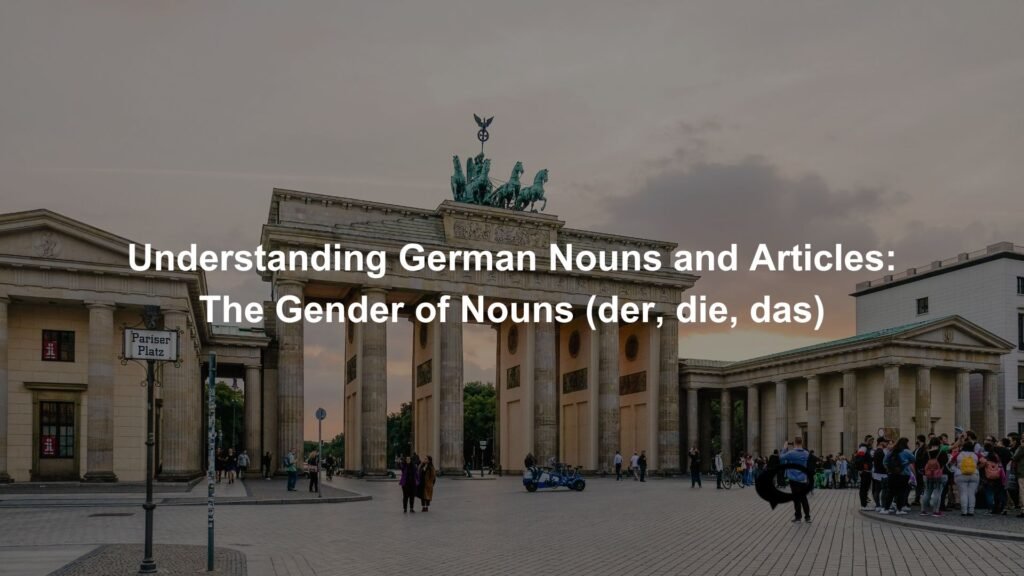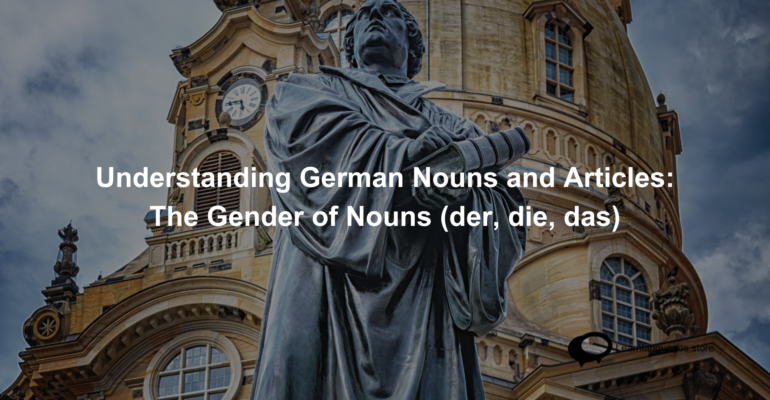Understanding German Nouns and Articles: The Gender of Nouns (der, die, das)
Understanding German Nouns and Articles: The Gender of Nouns (der, die, das)
Estimated reading time: 5 minutes

Welcome to Learn Languages Store! If you’re on a journey to master the German language, one of the essential steps is understanding the gender of nouns and their corresponding articles. In German, every noun is assigned a gender—masculine, feminine, or neuter—which determines the article you need to use: “der” for masculine nouns, “die” for feminine nouns, and “das” for neuter nouns. This blog will guide you through the rules, provide practical examples, and help you get a strong grasp of this fundamental aspect of German grammar.
Why Is Gender Important in German?
In German, unlike in English, the gender of a noun is crucial because it affects not only the article but also the adjectives and pronouns used with that noun. Learning the gender of each noun is necessary to speak correctly and fluently. While there are some patterns to help you determine the gender, there’s no hard and fast rule, so memorization and practice are key.
The Three Genders in German: Der, Die, Das
Let’s break down each gender with examples to help you understand how to use them correctly.
-
Product on sale
 German B1
German B1₹32,600.00
₹36,300.00 -
Product on sale
 German A2
German A2₹18,300.00
₹24,300.00
Der Tisch (Masculine)
- Article: der
- Gender: Masculine
Examples:
- Der Tisch ist groß.
Translation: The table is big.
Pronunciation (Hindi): दा टीश इस्त ग्रोस. - Ich habe den Tisch gestern gekauft.
Translation: I bought the table yesterday.
Pronunciation (Hindi): इख हाबे दैन टीश गेस्टर्न गेकौफ्ट. - Der Tisch wackelt ein bisschen.
Translation: The table wobbles a little.
Pronunciation (Hindi): दा टीश वाकेल्ट ऐन बिश्चेन. - Kannst du bitte den Tisch decken?
Translation: Can you please set the table?
Pronunciation (Hindi): कांस्ट डू बिट्टे दैन टीश डेकेन? - Der Tisch ist voll von Büchern.
Translation: The table is full of books.
Pronunciation (Hindi): दा टीश इस्त फॉल फॉन बूखर्न.
Die Lampe (Feminine)
- Article: die
- Gender: Feminine
Examples:
- Die Lampe ist sehr hell.
Translation: The lamp is very bright.
Pronunciation (Hindi): दी लाम्पे इस्त ज़ेयर हॅल. - Ich habe die Lampe repariert.
Translation: I repaired the lamp.
Pronunciation (Hindi): इख हाबे दी लाम्पे रेपारिएर्ट. - Die Lampe steht auf dem Tisch.
Translation: The lamp is on the table.
Pronunciation (Hindi): दी लाम्पे श्टेट औफ दैम टीश. - Kannst du die Lampe einschalten?
Translation: Can you turn on the lamp?
Pronunciation (Hindi): कांस्ट डू दी लाम्पे आइनशाल्टेन? - Die Lampe ist aus Glas.
Translation: The lamp is made of glass.
Pronunciation (Hindi): दी लाम्पे इस्त आउस ग्लास.
Das Buch (Neuter)
- Article: das
- Gender: Neuter
Examples:
- Das Buch ist spannend.
Translation: The book is exciting.
Pronunciation (Hindi): दास बूख इस्त श्पान्नेंड. - Ich lese das Buch jeden Tag.
Translation: I read the book every day.
Pronunciation (Hindi): इख लेजे दास बूख येदन टाग. - Das Buch liegt auf dem Tisch.
Translation: The book is on the table.
Pronunciation (Hindi): दास बूख लीग्ट औफ दैम टीश. - Hast du das Buch schon gelesen?
Translation: Have you read the book yet?
Pronunciation (Hindi): हास्ट डू दास बूख शॉन गलेज़न? - Das Buch hat viele Seiten.
Translation: The book has many pages.
Pronunciation (Hindi): दास बूख हाट फील ज़ाइटन.
Tips to Remember Gender in German
- Der (Masculine): Typically used for male persons or professions (der Mann, der Lehrer), and objects that end in -er, -en, -el.
- Die (Feminine): Common for female persons (die Frau) and nouns ending in -e, -heit, -keit, -ung.
- Das (Neuter): Often used for neutral nouns, diminutives (das Mädchen, das Häuschen), and words ending in -chen or -lein.
Conclusion
Learning the gender of German nouns and their corresponding articles can be challenging, but with regular practice and by using the examples provided, you’ll develop a better understanding of how to use “der,” “die,” and “das” correctly. Remember, consistent practice is key, and don’t hesitate to review these examples often until they become second nature.
Learn Languages Store
Vashi,
Email: services@learnlanguages.store
At Learn Languages Store, we’re dedicated to making your language learning experience engaging and effective. Keep practicing, and you’ll be mastering German grammar in no time!










